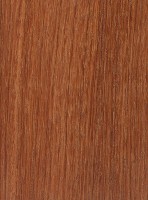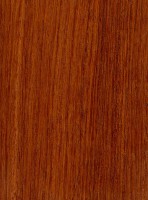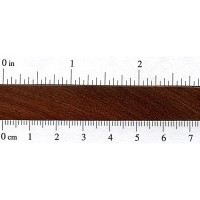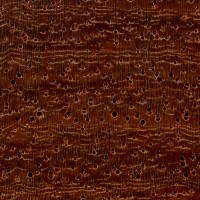  |
Common Name(s): Burma Padauk Scientific Name: Pterocarpus macrocarpus Distribution: Myanmar (formerly Burma), and Thailand Tree Size: 60-80 ft (18-24 m) tall, 2-3 ft (.6-1 m) trunk diameter Average Dried Weight: 54 lbs/ft3 (865 kg/m3) Specific Gravity (Basic, 12% MC): .75, .87 Janka Hardness: 2,150 lbf (9,550 N) Modulus of Rupture: 20,130 lbf/in2 (138.8 MPa) Elastic Modulus: 2,050,000 lbf/in2 (14.14 GPa) Crushing Strength: 9,030 lbf/in2 (62.3 MPa) Shrinkage: Radial: 3.4%, Tangential: 5.8%, Volumetric: 8.4%, T/R Ratio: 1.7 |
Color/Appearance: Heartwood color can vary, ranging from a pale golden yellow to a deeper reddish brown. Color tends to darken to a golden brown over time. Yellow sapwood is well demarcated from heartwood. Overall, Burma Padauk’s color tends to be less red and more subdued than African Padauk.
Grain/Texture: Grain is usually interlocked, with a coarse texture and fairly large and open pores.
Endgrain: Semi-ring-porous or diffuse-porous; large to very large pores in no specific arrangement, very few to few; solitary and radial multiples of 2-3; reddish heartwood deposits occasionally present; narrow rays not visible without lens, spacing fairly close; parenchyma diffuse-in-aggregates, winged, confluent, and banded.
Rot Resistance: Rated as very durable regrading decay resistance, with good resistance to termites and other insects.
Workability: Because of its higher density (as compared to African Padauk), and its interlocked grain, Burma Padauk can be difficult to work with. Burma Padauk turns, glues, and finishes well.
Odor: Padauk has a faint aromatic scent while being worked.
Allergies/Toxicity: Although severe reactions are quite uncommon, Burma Padauk has been reported as a sensitizer. Usually most common reactions simply include eye, skin, and respiratory irritation. See the articles Wood Allergies and Toxicity and Wood Dust Safety for more information.
Pricing/Availability: Available much less often than African Padauk, Burma Padauk is likely to be in the mid to upper range for an imported hardwood.
Sustainability: This wood species is not listed in the CITES Appendices or on the IUCN Red List of Threatened Species.
Common Uses: Veneer, flooring, turned objects, musical instruments, furniture, tool handles, and other small specialty wood objects.
Comments: Burma Padauk is the heaviest and hardest of all types of Padauk (Pterocarpus genus) commercially available. The color tends to be a bit more subdued than the more common African variety.
Scans/Pictures:
 |
 |
 |
 |

Cardigan walking stick with a Burma Padauk Burl handle. Very heavy & hard wood. Smells like heaven when sanded. The entire stick was burnished with micro mesh & finished with linseed oil. The Burma Padauk feels like glass when burnished this way.
In 2005 I had the unfortunate experience of making about 20 dovetail drawers out of this wood. After a few hours on the saws I noticed a rash forming on my forearms and had to stop and research what was going on. I have no other allergies, and was surprised at the reaction.
While a beautiful wood drawer when finished I have avoided this wood since!
The Home Woodworker